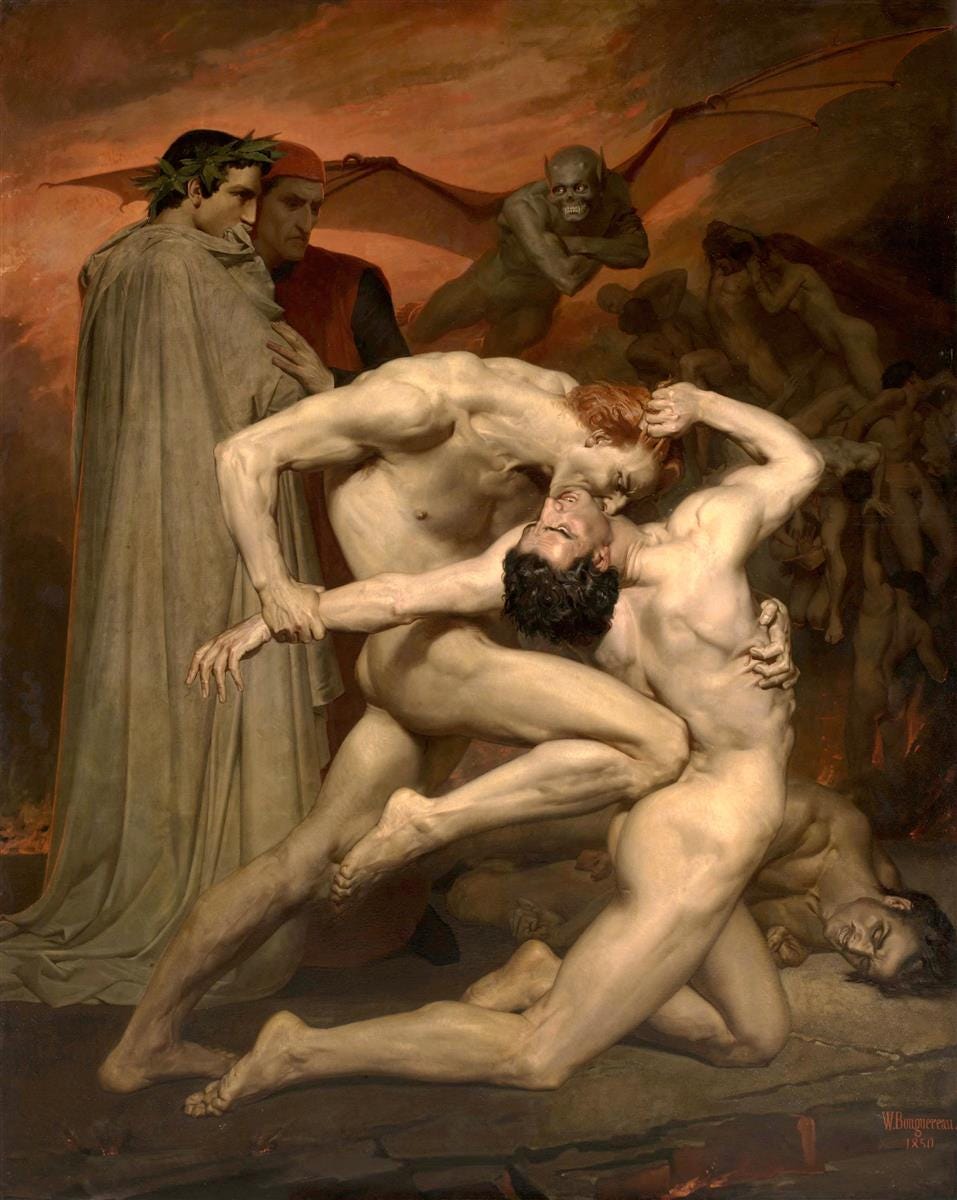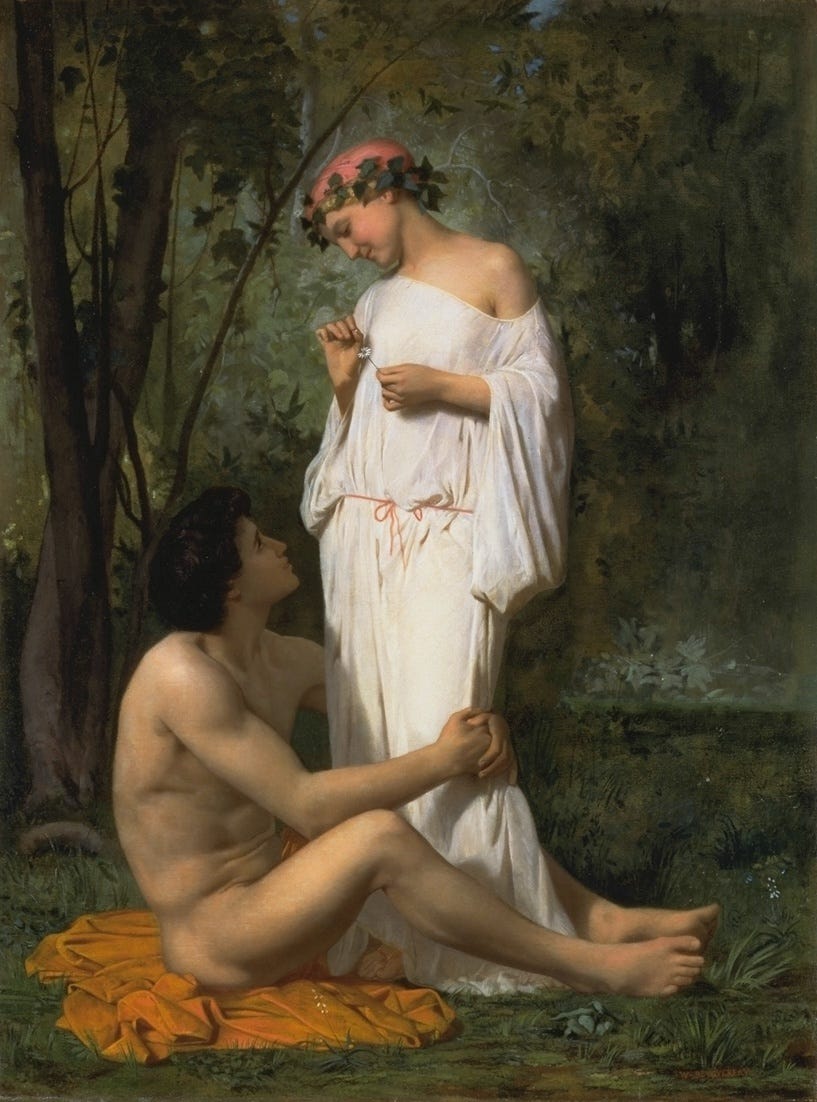William Bouguereau, #04
More quotes from the young painter's diary — a document that seems to have slipped into obscurity.
Marius Vachon’s biography of William Bouguereau was published in 1899 by Alexis Lahure (1849–1928), a printer with offices close by the Luxembourg Garden in Paris at 9, rue de Fleurus. As far as I know it is the sole contemporary account of the painter's life, which is why some remarks about and from the artist are in the present tense.
What follows is an excerpt from my translation (an uncorrected first draft). You can find previous instalments here.
Bouguereau’s constant need and desire to know more and more are evident in every page of his journal, and they are expressed with singular tenacity and energy. “Every moment of life must be employed in study,” writes the young artist on 28 April 1848. On 9 May, he adds: “Let us keep this great truth before our eyes at all times!” And these are not offhand remarks or castles in the air. On the following dates, there are precise notes on how he spent his time:
28 April: I will study architecture as soon as I can. It is essential. I feel the need of it more than ever. I am reading a rudimentary guide to architectural styles that will help me a little in my research. I will use my walks to study the different buildings that I come across and make a sketch.
12 May: Today I studied the customs of the Romans and Greeks, comparative anatomy, and Franz Joseph Gall’s system — a valuable discovery for painters.1
17 May: I worked: 1st on Greek clothing; 2nd on Roman clothing; 3rd at the Louvre; 4th at the École des Beaux-Arts, and 5th on anatomy…
22 May: Today I studied Barthélemy’s Travels of Anacharsis the Younger, the biography of Lord Byron, the customs of the Romans, then sketched at the École des Beaux-Arts, followed by physiology, including digestion, circulation, and the respiratory system (such magnificence and fragility!), a little bit of Dr. Gall, ligation, and the compression of arteries and veins...
30 May: Today I studied the style of the Hebrews and I will continue tomorrow, if I can I manage to find it!
In following this most rigorous course of study, the young artist’s ambition and desire was to master technique to the fullest — one which would give him the ability to handle both painting and underpainting adroitly. He made a thorough examination of the amphitheatres, and analyzed them as much as he could. “But for a fairly long time I did not know exactly where I was headed,” he told me one day. “I was undecided, worried, painfully nervous, and I was killing myself sketching.” Indeed, on the yellow pages of this journal, he often sums up his day’s and his night’s work with: “I can no longer see it clearly, I fall asleep.” The next morning, to bring himself around, he will pour jugs of cold water over his head with a wild energy.
While studying books and seeking to master the theory of his profession, Bouguereau also continued to make methodical observations on everything that surrounded him — on beings and things, on the phenomena of nature, and so on.
8 April: I also need to record an observation about the clouds. The lightest parts are at the top, and the clouds in that area will be always clearer and more transparent; sometimes, for example, the bottom is livelier, as in a setting sun, but it is only a golden ribbon, which only serves to confirm the rule.
14 May: During my walk I noticed swimmers (Canal Saint-Martin), thinkers, talkers, some lying, others standing (Bois de Vincennes), landscape effects, stormy weather... I also noted as much as possible about the expressions and characters of the faces I met. What beauties nature spreads out before our eyes! And we do not know how to enjoy it! ...
It is interesting to point out a peculiarity, something rare in the journal of a young artist: presumption and foolishness are absent, but there is an awareness that long, hard, and unyielding labour is required. The writer frequently admits his mistakes and gives himself advice with a touching sincerity that demonstrates both a character that is already fully formed, and an ardent desire for constant progress.
12 May: How many things I still have to learn before I can say that I am starting to understand. I will be lucky if the studies to which I must devote myself do not dim my imagination, if I can still feel exultant once I have acquired knowledge. The need I feel for them is certainly a safeguard for me, and yet....
13 May: When will the day arrive when I am able to do something worthy of a man? Unfortunately, there is much to learn before reaching that point. If I am starting to be able to express my ideas with the brush, I must seek out opportunities to do so, and this is something that reading may provide. It has to be done... But no, wait, spend a bit more time on dry and dreary studies, so that you don’t stumble on some little detail. But I still yearn to produce something. Lord, direct my steps, for the further I go, the more I see how small a thing man is, and my soul is doubtful. I desire excitement, and yet it would be better if this were not the case, for study requires calm and reflection; and I’m still a schoolboy, although I’m twenty-two!
On the 24 August, he has a sudden outburst of ill-temper and writes: “I am an ass.” He ends the next day with the following reflection, full of healthy humility, inspired by religious feeling and an awareness of the value his life will have if he perseveres with his work and artistic faith: “What shall I write today? Well? Nothing, except that I know very little and that I am nothing.” The journal ends with this naive confession.
If one is interested in the genesis of Bouguereau’s work, the document is of great interest. The seeds for all the ideas which guided him morally and socially during his life, all the principles which determined his method of composition and his way of working, they are all contained in this journal. As we will see, that seed will be nourished by new studies, serious and profound, and it will germinate and blossom vigorously. It will produce beautiful flowers and fine fruits.
☞ If you would like to know when the complete translation of Vachon’s biography becomes available (as a printed book and an ePub), sign up below.
Translator’s Note
As I wrote in a footnote to last week’s excerpt, I assume that it was Bouguereau's son Paul (1868–1898) who allowed Vachon to view the painter’s journal. I’ve looked on Gallica and Archive.org but can find no trace of it. Was it ever published?
Judging by this article in the New York Times, Bouguereau’s heirs still possess the studio on rue Notre-Dame-des-Champs in the 6th arrondissement of Paris. Perhaps they have the painter’s student journal. It is romantic to think of the manuscript tucked away in an attic, but if it still exists it is probably in a safety deposit box. Bouguereau’s La Jeunesse de Bacchus (shown in the NYT piece) sold for just under $21 million US in 2019, so an unpublished diary would be worth a great deal.
The phrenologist Franz Josef Gall (1758 –1828), who had settled in Paris and whose theories about the shape of the skull had become popular in France.



